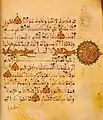Islamic calligraphy
Islamic calligraphy, also known as Arabic calligraphy, is the art of artistic handwriting, and by extension, of bookmaking.[1] It is both an art, and a practical way of writing.

Eighteenth century mirror writing in Ottoman calligraphy. The phrase means 'Ali is the vicegregent of God' in both directions.
Arabic calligraphy may be found on tiles and other ornaments. The text usually comes from the Koran (Qur'an).
Styles
The different styles of Arabic writing mostly derive from early versions of the Koran. There are geometric styles such as Kufic, and cursive (flowing) styles like Naskh, Thuluth, and Muhaqqaq.
Gallery
 Kufic script in a Qur'an from the 9th-10th centuries
Kufic script in a Qur'an from the 9th-10th centuries Naskh script in an Egyptian Qur'an from the 14th-15th centuries
Naskh script in an Egyptian Qur'an from the 14th-15th centuries
![Allah In Thuluth Script Allah's (Arabic) proportion rules.[ 1 ]](../I/Allah.JPG.webp)
 Inscriptions in calligraphy, form regular bands throughout the Qutb Minar, India, built 1192 CE
Inscriptions in calligraphy, form regular bands throughout the Qutb Minar, India, built 1192 CE Bismillah in calligraphy
Bismillah in calligraphy Bismillah in calligraphy
Bismillah in calligraphy The instruments and work of a student calligrapher.
The instruments and work of a student calligrapher.
References
- Bloom (1999), pg. 218
- Wolfgang Kosack: Islamische Schriftkunst des Kufischen. Geometrisches Kufi in 593 Schriftbeispielen. Deutsch – Kufi – Arabisch. Christoph Brunner, Basel 2014, ISBN 978-3-906206-10-3.
This article is issued from Wikipedia. The text is licensed under Creative Commons - Attribution - Sharealike. Additional terms may apply for the media files.